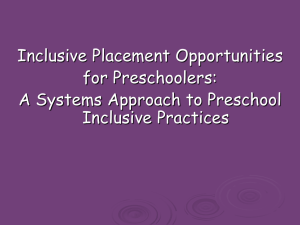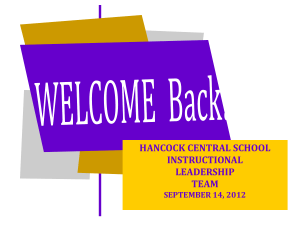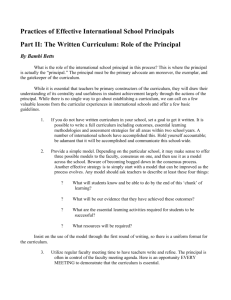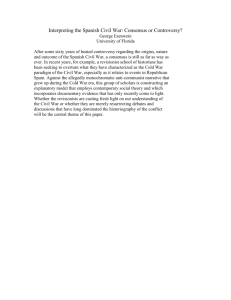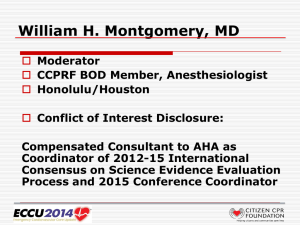What Will We Address With You Today?
advertisement
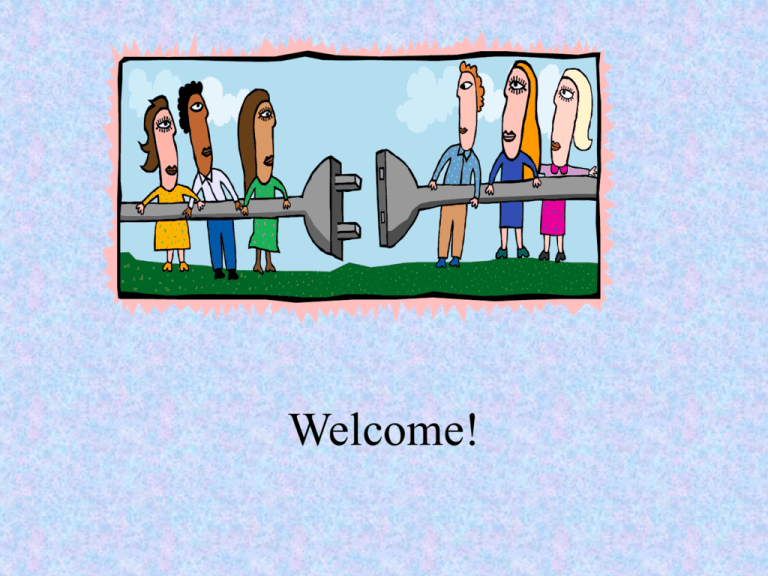
Welcome! What is a Collaborative Team? A group of diverse members who work together to share their expertise to address issues, solve problems or give recommendations that support the groups’ mission and goals What Makes a Team Effective? • • • • • • Shared beliefs and goals Diverse membership Shared leadership Consensus decision making Use of collaborative skills Rules for sensitive issues Activity What’s Your Teaming Type? Four Types of Team Members • Thinkers: Careful, precise, formal, private, reserved, logical, inventive, reflective • Directors: Take charge, control-oriented, competitive, motivated to be number one, task focused, achievers, strong willed • Socializers: Optimistic, fast paced, emotional, approval seeking, enthusiastic, impulsive, expressive • Relaters: Easy going, slow paced, diplomatic, predictable, persistent, modest, accommodating, friendly Four Ways People Operate • • • • Task Oriented (Thinkers and Directors) People Oriented (Relaters and Socializers) Fast Paced (Directors and Socializers) Slow Paced (Thinkers and Relators) How Can Your Team Support the Different Team Member Types? • • • • Thinkers: Accuracy and Precision Directors: Power and Control Socializers: Popularity and Prestige Relaters: Sincerity and Appreciation Stages of Team Development • Forming • Storming • Norming • Performing Forming Stage • Developing a sense of purpose and identity • Trust level low • Communication guarded Storming Stage • Search for group values, procedures and norms • Possible competing for group control and leadership • Erratic interactions • Communication may be angry, distorted, confrontational Norming Stage • Develop a shared sense of values, expectations, procedures and traditions • Openness in communication • Issues shared more easily Performing Stage • Strong sense of “we” and team cohesiveness • Efficient in making decisions and resolving conflict • Interactions patterns are group centered Skills Necessary for Collaborative Teaming • Exchanging information – Role release – Teaching each other • Communicating effectively – Beware of perceptions • Process for solving problems -Brainstorming solutions -Reaching consensus • Resolving conflicts Exchanging Information Through Role Release • As a team, look at the handout and quickly count the total number of squares seen. • Write the number of squares you find on a piece of paper and hold it up. Exchanging Information by Teaching One Another • A volunteer will give directions (without using eye contact or hand motions) to the group regarding how to draw a picture. • The audience is not allowed to ask questions. Communicating Effectively: Beware of Perceptions • Pick a partner • Each take 1 minute to share something your partner would not know about you • Partner receiving information will: – Listen without interrupting – Report to speaker what they heard/check for accuracy Process for Solving Problems • Clearly define the issue (if large, break into smaller issues) • Generate solutions • Decide on a solution • Evaluate effectiveness • Revise the plan as needed Clearly Define the Issue • State concerns/issues as problems to be solved by asking: What…? How…? When…? Where…? Generate Solutions Brainstorming: -No critical judgment allowed -Free-wheeling is welcome -Go for quantity, not quality -Use round robin strategy -Set short time period -Record words or phrases only Brainstorming Activity In your teams: – Think of places to go on a dream vacation – Follow rules for brainstorming – Have someone record ideas – You have 60 seconds – GO!! Consensus Decision Making Striving to reach a decision that best reflects the thinking of ALL team members Types of decisions Win-Lose Lose-Lose Win-Win = Consensus Solving Problems (Reaching Consensus) Before solving ask: – Are persons with responsibility and resources committed to resolving the problems? – What might happen if nothing is done to resolve it? – Does the problem warrant the effort and resources needed to accomplish significant change? – Are adequate time and resources available to resolve the problem? Guidelines for Making Decisions by Consensus Assume problems are solvable; avoid win-lose situations Present your position clearly and logically, listen to each team member’s reaction Seek out differences of opinions Involve everyone in the decision process Look for the next most acceptable alternative when the team reaches a stalemate Support only solutions with which you are at least somewhat able to agree Ask, “Is there anyone who cannot live with the solution?” Consensus Activity In teams: Reach consensus on a dream vacation Resolving Conflict Handling Conflict How do you handle conflict? When conflict occurs: • Face it and negotiate – Allow adequate time to discuss – Commit to resolve – Communicate viewpoint, focus on behaviors not personality traits – Use personal statement (“I”, “me”, “mine”) – Listen to other’s point of view – Be open to new perspectives – Reach agreement on definition of problem – Request and negotiate change WORK TOGETHER Reasons Teams Get Stuck • • • • • • • • • Too many meetings Too much time in a meeting Too many issues Too many talkers Too few talkers Not making decisions Rehashing decisions Not remembering what was decided Ignoring interpersonal conflict Team Meeting Process • • • Assign roles Set time limits Conduct Meeting – Celebrate – Review past meeting notes, carry incomplete tasks over as issues – LIST issues – Prioritize issues – Brainstorm solutions – Reach consensus on solutions – Record who will do what by when – Carry over issues not addressed Roles on Collaborative Teams • • • • • • Facilitator Agenda Keeper Time Keeper Recorder Encourager Observer How to Begin -Assign roles -Assign times -Celebrate -Review past notes, carry incomplete tasks over as issues During the Meeting -List issues -Prioritize -Brainstorm solutions for each issue -Reach consensus -Record (who, what, when) Ending the Meeting -List issues for carry over -List date, time and location of next meeting -Assign member to xerox/ distribute notes
